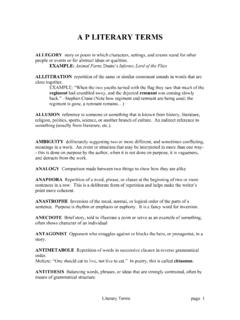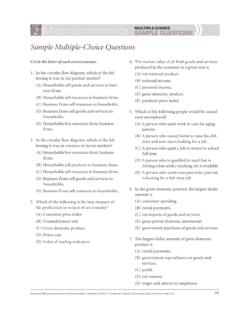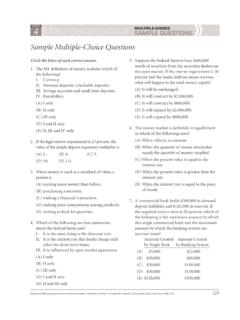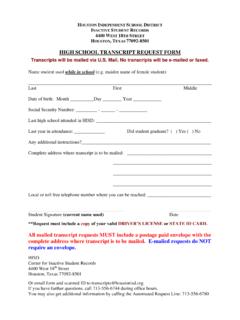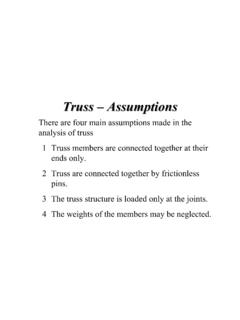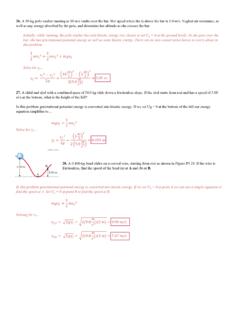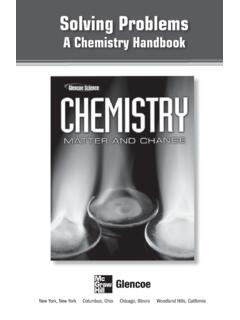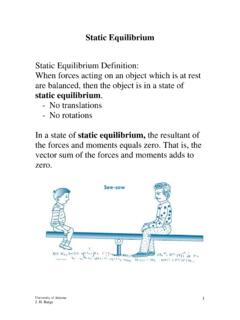Transcription of Hardy-Weinberg Equilibrium Problems
1 Hardy-Weinberg Equilibrium Problems 1. The frequency of two alleles in a gene pool is (A) and (a). Assume that the population is in Hardy-Weinberg Equilibrium . (a) Calculate the percentage of heterozygous individuals in the population. According to the Hardy-Weinberg Equilibrium equation, heterozygotes are represented by the 2pq term. Therefore, the number of heterozygous individuals (Aa) is equal to 2pq which equals 2 = or 31% (b) Calculate the percentage of homozygous recessives in the population. The homozygous recessive individuals (aa) are represented by the q2 term in the H-W Equilibrium equation which equals = or 66% 2. An allele W, for white wool, is dominant over allele w, for black wool. In a sample of 900 sheep, 891 are white and 9 are black.
2 Calculate the allelic frequencies within this population, assuming that the population is in H-W Equilibrium . The allelic frequency of w is represented by the q term and the allelic frequency W is represented by the p term. To calculate the value of q, realize that qq or q2 represents the homozygous recessive individuals or the black sheep in this case. Since there are 9 black sheep, the frequency of black sheep = # individuals900==, thus ww = q2 = = Additionally, p + q = 1 thus p = 1 q or p = 1 or p = W = and q = w = 3. In a population that is in Hardy-Weinberg Equilibrium , the frequency of the recessive homozygote genotype of a certain trait is Calculate the percentage of individuals homozygous for the dominant allele. We know that the frequency of the recessive homozygote genotype is q2 and equal to = AND we also know that p + q = 1 Thus, p = 1 q p = 1 = The homozygote dominants are represented by p2 = ( )2 = or 49% 4.
3 In a population that is in Hardy-Weinberg Equilibrium , 38 % of the individuals are recessive homozygotes for a certain trait. In a population of 14,500, calculate the percentage of homozygous dominant individuals and heterozygous individuals. Always start with the homozygous recessive percentage if given, which is equal to q2. q =2q q = q = Solving for p is now straightforward: p + q = 1, thus p = 1 q = 1 = The homozygous dominant individuals are represented by , 500 ,132 homozygous dominant individualsp== = The heterozygotes are represented by the 2pq term and 22 , 500 6, 859pq= = = Double check! 5, 5105, 510 2,132 6, 859 14, 501 (due to some rounding) =++ = 5. Allele T, for the ability to taste a particular chemical, is dominant over allele t, for the inability to taste the chemical.
4 Four hundred university students were surveyed and 64 were found to be nontasters. Calculate the percentage of heterozygous students. Assume that the population is in H-W Equilibrium . Calculate the percent of homozygotes recessive individuals 16% == which is the allelic frequency of t Additionally, p + q = 1 thus p = 1 q or p = 1 = which is the allelic frequency of T Solve for the heterozygote (Tt) term, 2pq 22 = or 48% of the population are heterozygous tasters and carriers of the recessive allele 6. In humans, the Rh factor genetic information is inherited from our parents, but it is inherited independently of the ABO blood type alleles. In humans, Rh+ individuals have the Rh antigen on their red blood cells, while Rh individuals do not. There are two different alleles for the Rh factor known as Rh+ and rh.
5 Assume that a dominant gene Rh produces the Rh+ phenotype, and that the recessive rh allele produces the Rh phenotype. In a population that is in Hardy-Weinberg Equilibrium , if 160 out of 200 individuals are Rh+, calculate the frequencies of both alleles. Always start with the homozygous recessive percentage if given, which is equal to q2. If 160 of 200 individuals are Rh+, then it stands to reason that 40 are Rh . Thus, the frequency of q2, the Rh genotype, is 40200 = q = or q = AND p + q = 1 so, p = 1 q = 1 = Rh+ allele frequency = and rh allele frequency = 7. In corn, kernel color is governed by a dominant allele for white color (W) and by a recessive allele (w). A random sample of 100 kernels from a population that is in H-W Equilibrium reveals that 9 kernels are yellow (ww) and 91 kernels are white.
6 (a) Calculate the frequencies of the yellow and white alleles in this population. Always start with the homozygous recessive percentage if given, which is equal to q2. The frequency of the yellow kernel recessive genotype ww is 9100 or = q2 q = 2q q = = = the frequency of w And p + q = 1 thus, p = 1 q = 1 = = the frequency of W (b) Calculate the percentage of this population that is heterozygous. The heterozygotes 22( )( ) 42% 8. A rare disease which is due to a recessive allele (a) that is lethal when homozygous, occurs within a specific population at a frequency of one in a million. How many individuals in a town with a population of 14,000 can be expected to carry this allele? Always start with the homozygous recessive percentage if given, which is equal to q2.
7 The frequency of the recessive genotype, q2 is 11, 000, 000 = q = 2q = = = the frequency of allele a AND p + q = 1 thus, p = 1 q = 1 = Therefore, the frequency of allele A = p = and the frequency of allele a = q = Carriers are heterozygous and are equal to 2pq. So, ()()( )22 14, (This should be reported as 28 individuals upon considering the rounding done throughout the mathematics.) Questions 9 & 10 refer to the following situation: Two Siamese and three Persian cats survive a shipwreck and are carried on driftwood to a previously uninhabited tropical island. All five cats have normal ears, but one carries the recessive allele f or folded ears (his genotype is Ff). 9. Calculate the frequencies of alleles F and f in the cat population of this island.
8 We are told that the genotype for the carrier is Ff. So, the other four cats are not carriers, thus their genotype for this trait is FF. Thus there are 10 total alleles within this population, 9 being F alleles and 1 being f. So, the frequencies are 910 or for F the allele and 110 or for the f allele. 10. If you assume Hardy-Weinberg Equilibrium for these alleles (admittedly very improbable), about how many cats would you expect to have folded ears when the island population reaches 20,000? The genotype of the cats with folded ears is ff which is equivalent to q2. Therefore, q2 = ( )2 = and the number of cats with folded ears is then equal to 20, 000 200 =cats. 11. In a certain African population, 4 % of the population is born with sickle cell anemia (aa).
9 Calculate the percentage of individuals who enjoy the selective advantage of the sickle-cell gene (increased resistance to malaria)? The individuals that are heterozygous enjoy the selective advantage of increased resistance to malaria and are carriers of the sickle cell trait. They have a genotype of Aa and are represented by the 2pq term in the H-W Equilibrium equations. We are told that 4% of the population is affected with sickle cell anemia, thus q2 = 4% = when expressed as a decimal. So, q = 2q or AND p + q = 1, thus p = 1 q = 1 = Thus, A allele has a frequency of and the a allele has a frequency of Therefore, the percentage of the population that is heterozygous (Aa) and are carriers is = ()()22 or 32%. 12. In the United States, approximately one child in 10,000 is born with PKU (phenylketonuria), a syndrome that affects individuals homozygous for the recessive allele (aa).
10 (a) Calculate the frequency of this allele in the population. Always start with the homozygous recessive data if given, which is equal to aa and to q2. The frequency of the recessive genotype, aa or q2 is 110, 000 = Thus, q =2q= = (b) Calculate the frequency of the normal allele. A represents the normal allele and is also represented by p in the H-W Equilibrium equations. p + q = 1 thus, p = 1 q = 1 = (c) Calculate the percentage of carriers of the trait within the population. The heterozygotes are the carriers of the trait and are represented by the 2pq term in the H-W Equilibrium equations. ()( )22 which is then multiplied by 10,000 to obtain the number of heterozygous carriers in the population. So, 10, 000 198 = individuals in the population that carry the trait.
